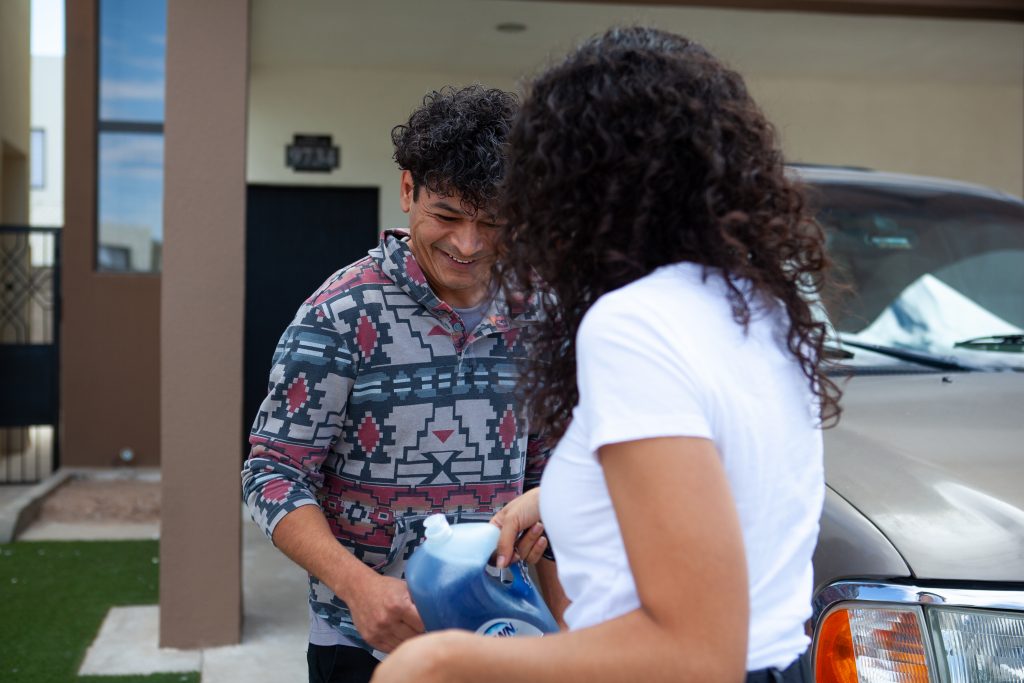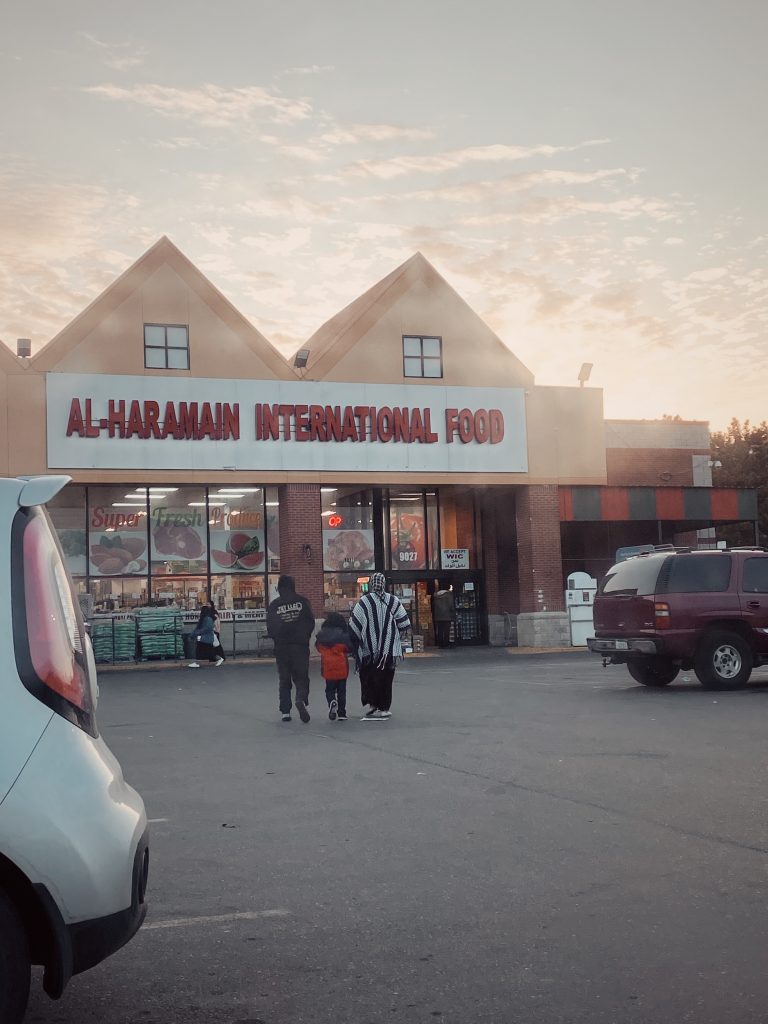By René Kladzyk / El Paso Matters Nathaly Gonzalez crosses from El Paso to Ciudad Juárez a couple times a week. She brings groceries to her grandparents — they prefer the bulk foods sold on the U.S. side. She visits her brother and takes her dog to the vet.

Gonzalez and her mother are dual U.S.-Mexican citizens and live in El Paso; her brother and grandparents are Mexican citizens and live in Ciudad Juárez.
Things have changed significantly for Gonzalez and her family since the COVID-19 travel restrictions went into effect on March 21, 2020, but she still crosses with ease, regardless of whether her reasons for crossing could be defined as “essential.”
“I’ve rarely had any issues with (Customs and Border Protection),” Gonzalez said. “And then crossing from El Paso to Juárez nobody really asks you anything. … I think my situation is very common here in El Paso.”

The COVID-19 border travel restrictions have only been partly enforced on the southern border of the United States. For Mexican nationals with tourist visas, like Gonzalez’s brother, the border has been effectively closed. But for U.S. passport-holders, although travel is technically restricted to “essential” purposes, “non-essential” crossing has continued with minimal obstruction.
In Detroit, 1,700 miles from El Paso, border crossing enforcement at the port of entry into Canada has been a wholly different story.
“Canada’s just been much more aggressive and much more conservative regarding the border during the pandemic than the U.S. has,” said Laurie Trautman, director of the Border Policy Research Institute at Western Washington University.
This more stringent approach by Canada has resulted in starkly different numbers for the reduction of border crossings between northern and southern United States ports of entry over the past year. While border crossings for pedestrians, passenger vehicles, and buses at the Canadian border were lowered by between 91% and 99% last year, on the Mexico border they lowered by a far smaller margin: between 35% and 68% depending on the type of crossing.
“Our approach is uniform at both borders,” said Roger Maier, spokesperson for Customs and Border Protection, noting that the travel restrictions are in place in order to “fight the spread of COVID.”
Although enforcement has been applied evenly by the United States, differential approaches by Canada and Mexico carry profound implications for U.S. border communities: economically, culturally and in terms of infectious disease.
The rationale for the border closure
In March 2020 the Department of Homeland Security announced that “in order to limit the further spread of coronavirus, the U.S. has reached agreements with both Canada and Mexico to limit all non-essential travel across borders.” Since then, the travel restrictions have been extended month after month over the past year.
Gonzalez said she thinks the border should have reopened by now, noting how hard it is for mixed-citizenship families like hers. When asked whether she thinks COVID-19 travel restrictions were worth it, she said “maybe at first, but not anymore.”
Some research has indicated that although border travel restrictions were effective in the early days of the pandemic (particularly when coupled with rigorous additional methods like testing, contact tracing, and quarantining), they became less effective over time.
“In three years, five years, when we do a post-mortem of COVID wins and losses, there’s going to be a lot of controversy as to, did our targeted interventions actually achieve the desired outcomes?” said Dr. Ogechika Alozie, an infectious disease specialist and El Paso physician.
Uneven COVID-19 severity among border communities
Looking at differential enforcement of border travel restrictions may offer insight into the drivers of infection rates in border communities, Alozie said.
El Paso-Juárez and Detroit-Windsor have some similarities as parallel high-population border metropolises, but had vastly different COVID-19 outbreak severity this past year.
El Paso and Detroit are the number one and number two least racially diverse cities in the United States, both with minority racial and ethnic populations in the majority. Both cities have median incomes well below the national average, and poverty rates well above the national average. Both El Paso County and Wayne County also have high levels of social vulnerability, according to the Center for Disease Control’s Social Vulnerability Index, which measures a community’s ability to mitigate suffering and economic loss during a disaster.
Wayne County is the most populous county in Michigan; its county seat is the city of Detroit.
Total COVID-19 cases were 150 percent higher on a per capita basis in El Paso County than in Wayne County, and total COVID-19 deaths were 20 percent higher. This is a simplified comparison because Detroit is a multi-county urban area. However, because Wayne County had a more severe COVID-19 toll than other suburban counties in Detroit, the discrepancy in overall COVID-19 severity between the two border communities is likely even greater.
“There seems to be an association between the lack of reduction in border traffic and the fact that we just had much more cases and deaths than the comparative city that’s also sitting on the border such as Detroit,” Alozie said. “It’s not causal — you can’t say one led to the other — but there does seem to be a clear data association when Detroit was having 95-99% reduction in traffic and here in El Paso it was only 60 to 70%.”
The potential mitigation of COVID-19 spread among border communities made the travel restrictions worth it, even if it wasn’t a 100% stopgap, said Eduardo Herrera, secretary of health for the Mexican state of Chihuahua.
“We do know that very great damage has been caused to the economy, but decisions had to be made to control the pandemic. And both Juárez and El Paso had the highest rates of infection of the virus, much stronger than other cities throughout the United States and throughout Mexico,” Herrera said.
The economic impact of border restrictions
The way that border travel restrictions affected the local economies of border communities was also uneven, largely tied to the ways the restrictions were enforced.
“The networks are reacting in totally different ways between the two sides,” Francesco Cappellano said, noting that Mexican border cities have been able to be more economically resilient to the COVID-19 border travel restrictions.
Cappellano, a researcher at the University of Eastern Finland, has been conducting research since 2017 comparing border communities of the San Diego/Tijuana region with the Washington State/ British Columbia region.
He said that varying pandemic responses by the three nations on a spectrum of strictness to laxness (Canada being the most stringent, the U.S. in the middle with an “ambivalent attitude,” and Mexico the most relaxed), has meant that the pressures of the border closure are experienced differently by different border communities.

For El Paso and Juárez, Cappellano’s assessment that the Mexican side is more economically resilient holds true, said Eduardo Ramos, president of Juárez’s combined chambers of commerce.
“The main victims of this are El Paso owners of commerce. Because El Paso depends (on shoppers) from Mexico,” Ramos said, explaining that the same is not true in reverse. “Juárez is more resilient than El Paso.”
Ramos said that he has observed few business closures during the pandemic, and emphasized that sales around Christmastime in Juárez were better this year than they had been in past years.
In El Paso, total small business revenues decreased by 32 percent when comparing March 2021 to January 2020, and 25 percent of small businesses closed during the same period, according to Track the Recovery.
Tom Fullerton, economics professor at the University of Texas at El Paso, agreed that the economic impacts of the border travel restrictions have been far more detrimental for El Paso than Juárez.
“It is a lot easier for U.S. citizens to cross the bridge since they’re not being stopped and questioned as they go into Mexico, so they’re probably still buying close to the same amount of items in Juárez that always would, but it’s not happening in the reverse direction,” Fullerton said.
“As a consequence of that, we’re probably observing one, a higher rate of business closures in El Paso; two, a higher rate of retail space vacancies; and three, lower rents per square foot for commercial real estate.”

Other economic impacts of the border travel restrictions will be difficult to measure, said Bill Anderson, director of the Cross-Border Institute in Windsor, Canada.
The deterioration of in-person business relationships and what that will mean for cross-border economic trust is a big issue, he said.
“The relationship here on this border is kind of personal. People know each other, they talk to each other a lot, they physically go back and forth across the border. And being separated for that long, it just seems to me it’s gonna have some sort of effect in the long-term in terms of the intensity of the economic relationship, that degree of integration across the border,” Anderson said.
Like El Paso-Juárez, the sister cities of Detroit and Windsor also have extensive manufacturing sectors, particularly connected to the automotive industry. Detroit-Windsor and El Paso-Juárez are also interconnected on this supply chain, with some Detroit-based companies expanding production to factories in border communities like El Paso-Juárez.
The incalculable toll on cross-border families
The cross-border patterns of Nathaly Gonzalez and her family are far from unique in El Paso-Juárez.
“It’s just normal,” Dania Gobea said, referring to frequent border crossing between El Paso and Juárez among families and friend groups. Gobea is currently a student at UTEP, but lives in Juárez. As a student, she has an “essential” purpose for continuing to cross, but said she has still had difficulties with CBP agents at the bridge because she is a Mexican citizen.
“It’s (more) normal for people in El Paso to come easily (to Juárez), than us to go in El Paso because they ask us questions when we go there,” she said.

Anderson said the Detroit-Windsor area also has a significant amount of families that are spread out across both sides of the border, particularly among the area’s large Middle Eastern immigrant population.
“One of the things that binds Detroit and Windsor together is the Middle Eastern community– particularly the Arab community, and you know they always say about Detroit, ‘the largest Arab population outside the Middle East,’ and the biggest immigrant group in Windsor is Lebanese,” Anderson said, noting that many Arab and Lebanese families in the area have family members on both sides of the border.

Canada has implemented border travel restriction exemptions for extended family members and “compassionate” reasons, for example in the case of a dying friend or a significant other who is a Canadian citizen. Although these enable some U.S. citizens under certain circumstances to travel to Canada for “non-essential” reasons, they are nonetheless reflective of the far greater limitations for crossing the northern border of the United States, as compared to the southern border.
“Another major difference between the two borders is Canada’s two-week quarantine requirement, which obviously Mexico doesn’t have, so that’s huge,” said Laurie Trautman, from the Border Policy Research Institute.
“I know a lot of people whose kids or parents live in Canada — they would technically be allowed to cross because they’re immediate family, but they’re supposed to quarantine for two weeks, so that in and of itself severely limits cross-border travel even from people that are able to go,” she said.
In that sense, familial barriers of the border closure are applied more stringently on the northern border than the southern border.
Nonetheless, border travel restrictions are acutely felt by families in El Paso-Juárez, even if enforcement of the restrictions is one-sided.
“If it was blocked both ways I have no idea what we would do,” Gonzalez said, describing all the ways her family has adapted because not everyone can cross freely.
“I just wish the borders were open,” she said. “There’s a lot of implications of closing the border, especially here. And I think they should be able to open now.”
UPDATE: On Thursday, after this story was published, Mexico announced that it would begin enforcing a restriction on non-essential travel across its northern and southern borders.
Cover photo: Vehicles line up on Avenida Juárez at the foot of the Paso del Norte International Bridge on March 10. Despite COVID-19 travel restrictions, thousands of people cross each day between El Paso and Ciudad Juárez. (Corrie Boudreaux/El Paso Matters)

